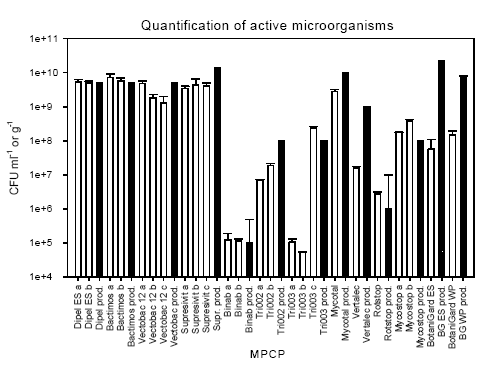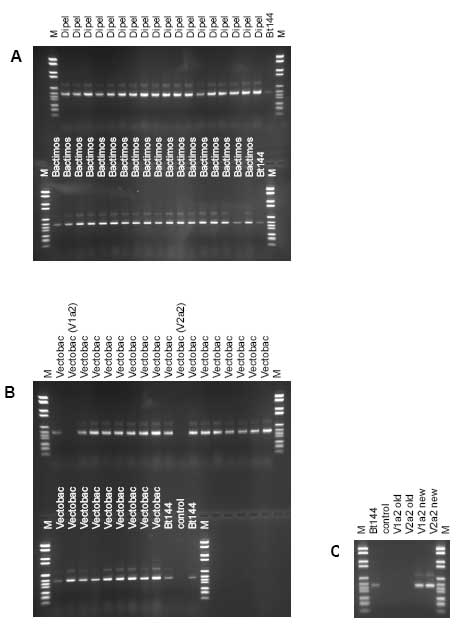|
Quantification and Identification of Active Microorganisms in Microbial Plant Protection Products 3 Results
3.1 Available information on the microbial plant protection productsIt is noted that not all the collected MPPP was labeled with the required information regarding batch number and date of production and expiry (Table 3.1). One batch of Bactimos L and Supresivit, and both batches of Mycostop did not have any batch number. Bactimos L, Vectobac 12AS, and Tri002 had no date of expiry, while the date of expiry for Tri003 was indicated as one year after the date of purchase. This date does not take the storage time at the supplier into consideration. The date of expiry of Supresivit was 14 months after production date, which was not indicated. This makes the date of expiry of little value. Finally, for Dipel ES shelf life was 2 years. However, this information is of no use since no date of production is indicated. The number of active micro-organisms was not indicated on the product label of products based on Bacillus thuringiensis (Bt products). At these products the toxicity of the micro-organisms was indicated as International Toxic Units (ITU) (FAO 2004). However, the producer has subsequently informed us that the approximate CFU was 5 x 109 CFU ml-1. The producer of the products Tri002 and Tri003 has informed us that the products should contain 108 CFU g-1. 3.2 Quantification of active micro-organismsThe number of CFU of the active micro-organisms found in the various products is shown in Table 3.1 and Figure 3.1. All products based on Bt contained 1.29 – 7.31 x 109 CFU ml-1. The producer's information of abundance was 5 x 109 CFU ml-1, and some EU member states suggested an acceptable deviation of 5 times higher and lower abundance, which results in an acceptable range of abundance of 1 x 109 to 2.5 x 1010 CFU ml-1. Hence, the observed number was well within this range. The products Binab TF WP, Rotstop, and Mycostop also contained a number of active micro-organisms close to the number found in the producers' information. Of the four products based on the fungi Trichoderma spp., the abundance of active micro-organisms in Supresivit was 25-31 % of the indicated abundance. The abundance of active micro-organisms in Binab TF WP followed the specifications of the product and contained 1– 5 x 105 CFU g-1. The Tri002 and Tri003 products were expected to contain approximately 108 CFU g-1. However, we found a highly variable number of active micro-organisms in these products. Tri003 batch no. 0031 contained only 5.24 x 104 CFU g-1, while the other batch contained 2.43 x 108 CFU g-1. The Tri002 batches contained 0.7 – 1.9 x 107 CFU g-1. Hence, only one Tri003 batch contained a number of active micro-organisms close to the number specified by the producer. Table 3.1: The number of colony-forming units (CFU) of the active micro-organisms in the microbial plant protection products tested in this study. For comparison, the number of CFU or spores according to the producers' information is included.
*: data available from the data package submitted to the Danish EPA na: not available
Figure 3.1: The number of active micro-organisms quantified in the products (open bars) and the number of active micro-organisms in the products as informed by the producers (hatched bars). a, b, and c denotes replicate batches of the products. Error bars show standard deviation for the tested products. For the producers' information the error bars indicate the upper limit of abundance and the bar the lower limit. Mycotal contained slightly below the expected number of active micro-organisms, while Vertalec contained a tenth of the number specified. BotaniGard ES and 22WP with the fungi Beauveria bassiana contained only 0.25% and 0.4%, respectively, of the number indicated on the container and 1-2% of the number indicated in the data package submitted with the application. 3.3 Identification of Bacillus thuringiensisThe morphology and visual appearance of the bacterial colonies on the agar plates were similar for all colonies. 3.3.1 Molecular analysisThe results of the molecular analysis by PCR-ITS showed all 63 Bt isolates to have identical band patterns and share band pattern with the reference strain B. thuringiensis subsp. kurstaki HD1 (Bt144), which is a strong indication that they belong to the same phylogenetic group (Figure 3.2A-C). Two isolates from Vectobac 12AS (V1a2 and V2a2) did not show any bands on the first gel (Figure 3.2B). However, after DNA extraction from another overnight culture of the isolates, PCR-ITS followed by gel analysis showed bands (Figure 3.2C). 3.3.2 Crystalline inclusions containing delta-endotoxinOf the 63 isolates tested only one isolate from Bactimos L, batch number 105-421-N9, did not contain crystals. The remaining eight isolates from this batch did contain crystals. PCR-RAPD analysis enabling differentiation between variants of Bt was performed on this isolate according to Hansen et al. (1998) and showed that the isolate was indeed a B. thuringiensis subsp. israelensis (Hansen 2004). 3.4 Identification of fungi and actinomycetesThe active micro-organism in Mycostop, supposed to be Streptomyces griseoviridis, was identified by DSMZ to be Streptomyces umbrinus (Appendix b). This identification was based on a sequence similarity of a 500-nucleotide long variable part of 16S rDNA of 99.5% and good correlation in fatty acid markers, in addition to results of other markers and physiological tests. Differences in identification results can be related to the identification keys used and the tests performed. However, the DNA sequence homology is considered as one of the most important characters for identification of bacteria. The active micro-organism in Mycotal was identified to be a Lecanicillium muscarium, and the active micro-organism in Vertalec was identified to be a Lecanicillium longisporum. According to the producer's information the active micro-organisms in these two products were two different strains of Verticillium lecanii. However, in 2001 the taxonomy of this genus was revised and the two strains segregated into two new species (Zare and Gams 2001). This taxonomy is primarily based on morphological and phenotypic characters (Appendix b). The remaining fungal isolates were identical to the species specified by the producers (Appendix b).
Figure 3.2: Band patterns of the products of polymerase chain reaction of the internally transcribed sequence (PCR-ITS) of DNA from bacterial isolates from the Bt products after electrophoresis in 2% agarose gels. Bt144: Bacillus thuringiensis subsp. kurstaki HD1; M: molecular weight marker; control: no added DNA template to PCR. A: In the upper panel 18 isolates of Dipel ES, in the lower panel 18 isolates of Bactimos L. B: In the upper panel 18 isolates of Vectobac 12AS, in the lower panel nine isolates of Vectobac 12AS. C: PCR-ITS products of the Vectobac 12AS isolates that did not yield a product in gel B. Shown are the old PCR-ITS products not yielding any bands (also shown in gel B) and the new PCR-ITS products yielding bands of V1a2 and V2a2. 3.5 Detection of contaminating bacteriaThe experiments were not designed to detect contaminating bacteria but to enumerate the active micro-organisms. As such the level of detection was rather high (2.8 x 102 – 1.1 x 107 CFU g-1 or ml-1) and depending on the number of the active micro-organism. Additionally, the media used was optimal for the active micro-organism and not necessarily for contaminating bacteria. In spite of this, contaminating bacteria were found in 7 batches of fungal-based MPPP (Table 3.2). Significant numbers of contaminating bacteria were found in Supresivit (all three batches), Tri002 (batch no. 0402) and Tri003 (batch no. 0031). Furthermore, few bacteria (1 to 12 per plate) were found in Tri002 (batch no. 0326) and in Rotstop. No contaminating fungi or bacteria were detected in the Bt products Dipel ES, Bactimos L, and Vectobac 12AS, the actinomycete product Mycostop, and in the fungal products Binab TF WP, Mycotal, Vertalec, and BotaniGard ES and 22WP. Table 3.2: The abundance of contaminating bacteria in the tested microbial plant protection products is indicated as the number of colony-forming units (CFU). When available, the producers' information of the number of CFU or spores of other micro-organisms than the active micro-organism is shown.
bd: below detection level na: not available
|
||||||||||||||||||||||||||||||||||||||||||||||||||||||||||||||||||||||||||||||||||||||||||||||||||||||||||||||||||||||||||||||||||||||||||||||||||||||||||||||||||||||||||||||||||||||||||||||||||||||||||||||||||||||||||||||||||||||||||||||||||||||||||||||||||||||||||||||||||||||||||||||||

